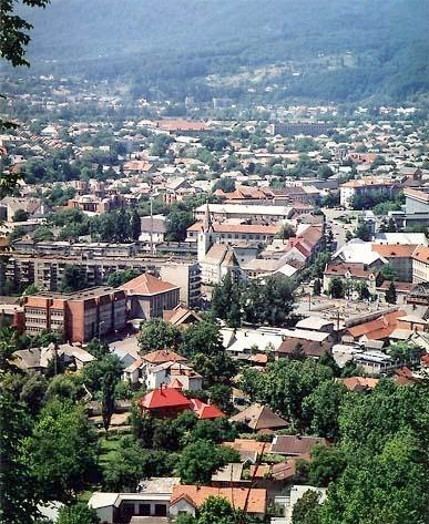Incorporated 1329 Area 8 km² Local time Monday 12:10 PM | Founded 1090 Elevation 164 m (538 ft) Population 28,448 (2016) | |
 | ||
Weather 12°C, Wind NW at 8 km/h, 53% Humidity | ||
Khust (Ukrainian: Хуст, German: Chust, Hungarian: Huszt) is a city located on the Khustets River in Zakarpattia Oblast (province) in western Ukraine. It is near the confluence of the Tisa and Rika Rivers. Serving as the administrative center of Khust Raion (district), the city itself does not belong to the raion and is designated as a city of oblast significance, with the status equal to that of a raion. Population: 28,448 (2016 est.).
Contents
- Map of Khust Zakarpatska Ukraine
- Origin of name
- History
- Demographics
- Climate
- Tourist sights
- Famous people
- Yeshiva
- Rabbis
- References
Map of Khust, Zakarpatska, Ukraine
Khust was the capital of the short-lived republic of Carpatho-Ukraine.
Origin of name
The name is most possibly related to the name of the stream Hustets or Husztica, whose meaning is "kerchief". It is also conceivable that the name of the city comes from a Romanian traditional food ingredient - husti.
There are several alternative names used for this city: Russian and Rusyn: Хуст, Romanian: Hust, Hungarian: Huszt, Czech and Slovak: Chust, Yiddish: חוסט, German: Chust.
History
The settlement was first mentioned as Huszth, in 1329. Its castle was built in 1090 by king St. Ladislaus of Hungary as a defence against the Cumans, was destroyed during the Mongol invasion of Hungary and was rebuilt around 1318. The town got privileges in 1329.
In 1458 King Matthias imprisoned his uncle, the rebellious Mihály Szilágyi in the castle. In 1514, during György Dózsa's peasant revolt local peasants captured the castle. In 1526 the area became a part of Transylvania.
The army of Ferdinand I captured the town in 1546. In 1594 the Tartars destroyed the town, but could not take the castle. The castle was besieged in 1644 by the army of George I Rákóczi, in 1657 by the Polish, in 1661-62 by the Ottoman and Tartar hordes. Count Ferenc Rhédey, the ruling prince of Transylvania and high steward of Máramaros county died in the castle on May 13, 1667.
The castle surrendered to the Kurucs on August 17, 1703, and the independence of Transylvania was proclaimed here. It was the last castle the Habsburgs occupied when suppressing the freedom fight of the Kurucs, in 1711. The seriously damaged castle was struck by lightning and burnt down on July 3, 1766; a storm brought down its tower in 1798, it has been in ruins ever since then. Khust was renamed as Csebreny in 1882 during Magyarization process.
In 1910 Khust had 10,292 citizens, 5,230 Ruthenians, 3,505 Hungarians and 1,535 Germans. Until the Treaty of Trianon it belonged to Hungary and was the seat of the Khust district of Máramaros county. After World War I, in summer 1919 the Rumanian troops took over the territory. But according to the St.-Germain treaty Czechoslovakia received the city, as part of newly formed Podkarpatsko ("under the Carpathians") region (Subcarpathia). Czechoslovakia had to provide the region a wide autonomy, but autonomy was realised only in 1938. In Autumn 1938 an autonomous government was organised. The day after the collapse of Czechoslovakia on March 14, 1939, the Khust city government proclaimed, by the will of the local population, independence as Carpathan Ukraine on March 15, 1939. Next day, on March 16, 1939 Hungarian troops invaded Khust and claimed it as part of Hunagary. On October 24, 1944 Soviet troops occupied the city, and annexed it into the Soviet Union. The Soviet government deported most of the city's German Hungarian and Ukrainian population to the Gulag. Since the collapse of USSR, Khust is part of Ukraine.
Demographics
In 2001 it had 31,900 inhabitants, including:
Until the 19th century the city's population also included ethnic Romanians (800 Romanians according to the 1880 census).
Climate
Khust has an oceanic climate (Köppen: Cfb).
Tourist sights
Famous people
Rabbi Zeev ben Moshe Feuerlicht (born 1918), studied in Romania, in yeshiva of Satu-Mare Rebbe, during the Liberation of Czechoslovakia from Nazi Germany he joined as an active fighter the Gen. Ludvik Svoboda Army, served in Prague synagogue Alt-neu Shul as a Rabbi, educator and shochet. Rabbi Feuerlicht should be credited for the survival of the Orthodox community in Czechoslovakia after WW II.
Yeshiva
In 1861, Rabbi Moshe Schick, known as the "Maharam Schick" established - what was at that time - the largest yeshiva (Torah academy) in Eastern Europe, in Khust. This yeshiva had over 800 students.
